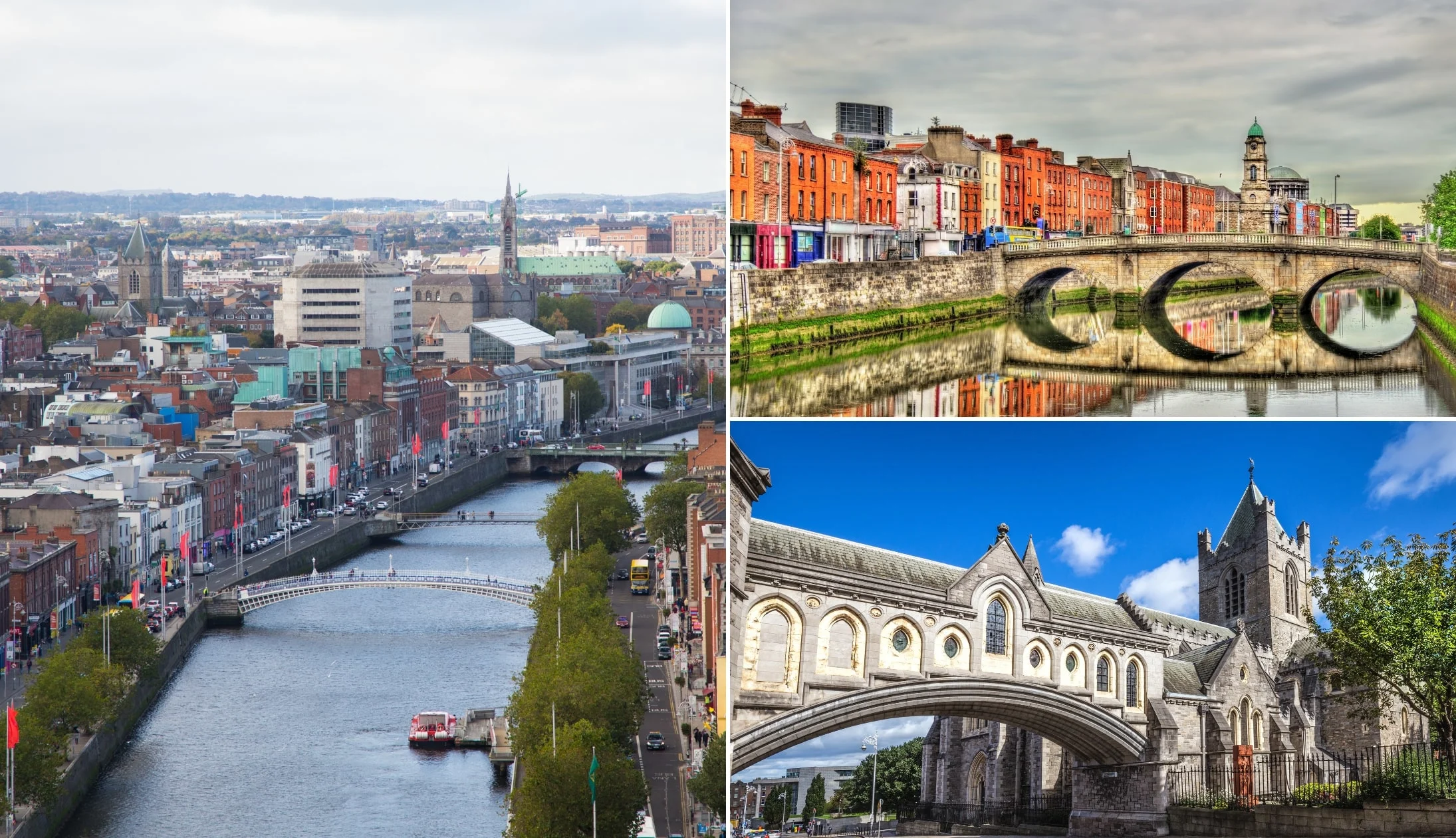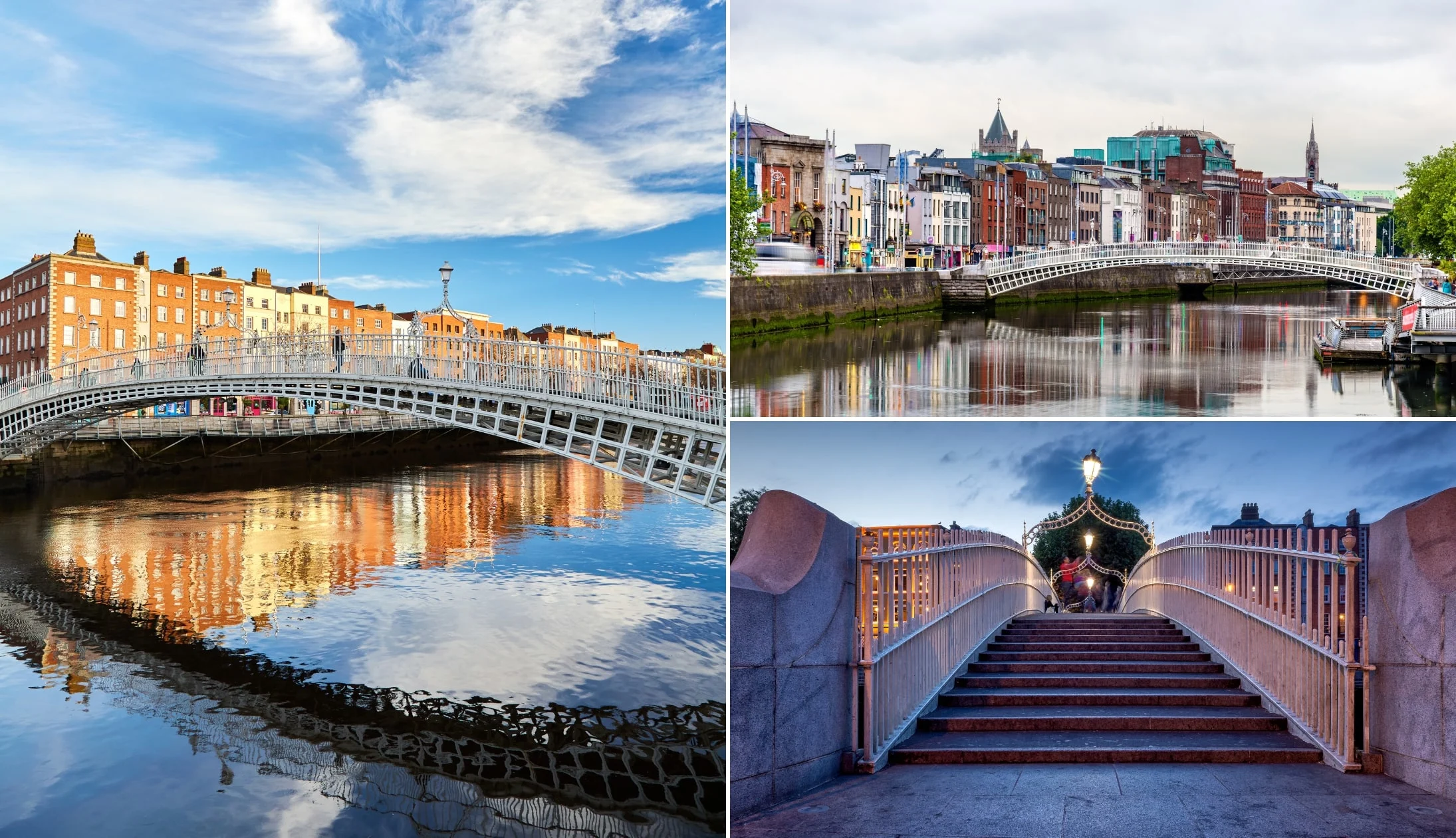Renting a car in Dublin for the first time can be a nightmare to get your head around.
There’s a huge amount of information to absorb and, in our opinion, many Dublin car rental companies make the process deliberately confusing.
The result is often that you’ll either end up paying more than you need to or you won’t get sufficient insurance coverage.
The most important thing to do before looking at car rental Dublin prices/companies is to take 5 minutes to educate yourself on the need-to-knows.
Some quick need-to-knows before renting a car in Dublin

Photos via Shutterstock
Unfortunately, renting a car in Dublin isn’t always straightforward. Sadly, there are a lot of rental companies that make it overly complicated. Get up-to-speed fast with the Dublin car rental points below:
1. It’s easy to be conned
One common trick used by rental companies is to stick on a €22 surcharge if you’re picking your rental up from the airport. When you get a quote online, this fee won’t be mentioned anywhere. It’s simply added on and payable at the airport, often leaving you with no choice but to pay it.
2. They make rental insurance unnecessarily confusing
Dublin car rental insurance is made far more confusing than it needs to be. Sadly, it looks as if this is a deliberate attempt to help rental companies inflate their bottom line. You’d think that the appropriate insurance would be included in the price, with easy options to upgrade if required. Unfortunately, that’s rarely the case.
3. Pick-up location impacts the price
As we’ve mentioned above, if renting your car in Dublin Airport, you’re likely to be hit with a €22 surcharge for the privilege. More often than not, it’s cheaper to take the bus into the city and pick up your rental from a different location.
4. Beware of the key requirements
Not everyone is able to rent a car in Dublin. Most rental companies have a minimum age of at least 25 (some are higher). You’ll also need to provide a valid driving licence and ID, and more often than not, you’ll need to use a credit card.
5. Compare prices with Discover Cars
If you’re looking to rent a car in Dublin and you’d like to see how the various companies stack up against each other, try Discover Cars (they have a 4.5/5 rating on Trustpilot from 50,000+ reviews at the time of typing). If you rent a car through them, thank you. We’ll earn a small commission which helps us keep this site running – genuinely, thank you!).
6. Follow our handy 8-step process
If you’re in the early stages of planning a trip to Ireland and aren’t sure how to go about renting a car in Dublin, don’t worry – we have a very straightforward 8-step process to follow below.
Step 1: Decide if you really need to rent a car in Dublin (many don’t)

Photos via Shutterstock
In our opinion, you should only consider renting a car in Dublin if you’re moving straight out of the county. Getting around Dublin via public transport is very straightforward.
Many of the best things to do in Dublin are easily accessible via bus or train. However, here are some considerations:
1. If you’re exploring Dublin City
If you’re not planning to leave Dublin City on your trip, then we can say that you almost certainly don’t need to rent a car in Dublin. In fact, renting a car can actually hinder your experience in Dublin, as you’ll have to tackle awkward one-way streets, mess around with parking, and put up with traffic.
Dublin City enjoys excellent public transport. From the airport, the Dublin Airport Express takes just 17 minutes to reach the city centre and only costs €7 one-way or €9 for a return ticket. Best of all, services run more or less every 15 minutes from around 4 am to past midnight.
The city itself is wonderfully walkable, with plenty of pedestrian streets and squares. There’s also the LUAS tram service and the DART (Dublin Area Rapid Transport), as well as a slew of bus services that’ll take you pretty much anywhere you need to be in town.
Best of all, the various Dublin Hop-On Hop-Off Buses take in all of the city’s major attractions, while providing a fascinating tour.
2. If you’re exploring Dublin County
If you’re planning to get out of the city and enjoy the surrounding countryside of Dublin County, you still might not necessarily need to rent a car to do so.
Public transport in this part of Ireland is pretty good, and you’ll find either a train or bus service to take you to the majority of the best day trips from Dublin.
For example, you could jump on the St. Kevin’s bus to Glendalough in the Wicklow Mountains. With regular services and affordable tickets, it’s a great alternative to renting a car and driving.
Alternatively, you’ll find countless organised day trips from Dublin to the surrounding area.
So, if you want to check out Newgrange and other incredible sights in Meath and the Boyne Valley, or even go as far as the Cliffs of Moher or the Giant’s Causeway, you still don’t necessarily need a car to do so.
Step 2: See if you meet the rental requirements

Photos via Shutterstock
If you decide that you do want to rent a car in Dublin for your trip, the next step is to check that you meet all of the various requirements.
There are three main’ requirements for renting a car in Ireland that you need to consider:
1. Valid ID and driver’s licence
You’ll need a full, valid driver’s licence in order to rent a car in Dublin. By valid, we mean that it’s in date and has been issued by a recognized authority.
Licences issued in any EU or EEA member state and the UK enable you to drive in Ireland indefinitely. Licence holders from outside of these areas, such as the U.S., Canada, and Australia, are able to drive in Ireland for up to a year.
In some cases, you may be required to obtain an International Driving Permit (IDP). Be sure to check the regulations that apply to your country. In addition, you’ll typically need to provide valid ID, such as a passport or EU National Identity Card.
2. Minimum and maximum age restrictions
Different rental companies have different age limits, but for the most part, if you’re under 25 you’ll probably not be able to rent a car in Ireland. In fact, some companies have a minimum age limit of 30, so be sure to check ahead.
You might also come across rental companies that apply extra rules for drivers over 75 years old.
3. Credit card requirement
Strangely, many car rental companies in Dublin won’t accept debit card payments and will insist that you pay with a credit card. More often than not, you’ll need to bring this with you to the rental counter, and a refundable security deposit may be taken if it hasn’t been already.
Some companies do allow you to rent a car in Dublin without a credit card, but it’s worth checking ahead. As an example, you can use a debit card at Enterprise, as long as you’re not renting your car from the airport.
Step 3: Get your head around car rental insurance

Photos via Shutterstock
When it comes to renting a car in Dublin, the insurance has got to be one of the most confusing parts. Not only is it difficult to get your head around, but it’s also the element that can cause the cost of your rental to go through the roof.
After adding insurance, what might’ve seemed like a great deal can suddenly become outrageously expensive. Here’s what you need to know.
1. What is Car Hire Excess?
In a nutshell, Car Hire Excess is the amount of money that you’ll have to pay towards repairing any damage that might occur while the car is in your hands.
Even though all car rentals will include the most basic insurance in the price, if something goes wrong, you’ll be liable to pay a fixed amount towards any repairs.
Car Hire Excess is basically the amount of cash that car rental companies in Dublin won’t cover if you need to file a claim.
2. Third-Party Liability Insurance is required by law
All Dublin car rental companies are required to provide Third-Party Cover—also known as TPC, Legal Liability Insurance, or Motor Liability—and it should be included in the standard rental price. It’s not an add-on, and you shouldn’t have to pay an extra fee for it.
Third-Party Liability Insurance is basically the minimum level of cover that you need to legally for driving in Ireland. It covers you for damage to someone else’s property or vehicle, as well as any injury you might cause to another person.
It doesn’t cover any damage to your own car or any legal and medical costs that you might incur after an accident.
We wouldn’t recommend driving a rental car with such a low level of insurance, simply because if you have an accident or damage the vehicle, you can end up paying huge amounts in repairs and even legal and medical fees.
3. Make sure you know what’s included in the rental price
While all Dublin car rental companies must provide Third Party Insurance by law, many add additional insurance as standard. Now, you should normally be told this in advance and it should be clearly stated in the rental agreement.
Rental companies tend to throw in Vehicle Theft Cover and a Collision Damage Waiver. But, be sure to check this in advance and before you sign anything, make sure the pricing is crystal clear.
4. Collision Damage Waiver (CDW)
Here’s where you’ll normally find the biggest source of confusion when it comes to renting a car in Dublin. The CDW is essentially an extra type of insurance that you can take out when you rent a car in Dublin, either via your rental company or through a third party.
Some companies will add the CDW on as standard, but more often than not it’s optional and is typically charged by the day. When you buy a CDW, be sure to know what the excess fee is, i.e. how much you’ll have to pay if you make a claim.
Generally speaking, the cheaper the insurance is, the more excess you’ll have to pay.
Still confused about the CDW? Let’s go over the basics:
- What does CDW do? It essentially reduces the excess amount that you’re liable to pay if your rental car is stolen or damaged.
- Can I decline the CDW? In many cases, you can, but it’s not always a good idea. If you do decline it, many rental companies will require you to sign a contract stating that you’re fully responsible for the value of the car. In addition, they may block a certain amount of cash from your credit card. We’ve heard that people have had up to €2,000 placed on hold during the rental period.
- Does my credit card cover CDW? Some credit cards do offer this type of cover, but you’ll need to check that it allows you to drive in Ireland and that the car rental company will accept it
5. Super CDW
While CDW covers you for major accidents, you’ll still be liable for minor scuffs and scrapes. Generally speaking, with regular CDW, you’ll have an excess of €600 to €2,600.
That means you’ll still have to pay the first €600 to €2,600 towards repairs if something happens to your Dublin car rental.
With Super CDW, you’re often able to pay a little bit more, but reduce your excess to zero. So, in case of an accident, you won’t have to pay anything towards the repairs. Super CDW costs vary from company to company but can be around €20 per day or so. Be sure to check, as prices do fluctuate.
But, be sure to read the small print. Sometimes, even with Super CDW, you won’t be covered for things like wheel damage, lost or damaged keys, or putting the wrong type of fuel in the tank.
If in doubt, ask your Dublin car rental company to provide a clear breakdown of what’s included in the price.
6. Our advice when it comes to insurance
Renting a car in Dublin is expensive and it can cause the cost of a trip to Ireland skyrocket, so it’s tempting to go bare-bones on the insurance.
However, we’d strongly recommend that you consider taking out decent level of insurance. Hopefully you won’t need it, but it’s better to be safe than sorry.
Step 4: How to save yourself time, hassle and money

Photos via Shutterstock
If you’ve made it this far in our Dublin car rental guide, congratulations! We know it seems a little long-winded, but we really are sticking to the essentials here!
If you read through the whole thing, it will save you time, stress, and money when you come to rent your car in Dublin.
With that in mind, if you follow the points below, the whole process will be a breeze.
1. Take time to read through the Ts&Cs of your car rental
This might be the most important bit of advice you can take from this guide. Reading through the terms and conditions of your Dublin car rental agreement and making sure you understand it is essential.
You shouldn’t sign anything until everything is crystal clear.
One of the main reasons that people have bad experiences with Dublin car rental companies is that they didn’t do their research and didn’t fully understand the terms and conditions.
2. Booking ahead will result in better rates
The later you leave it to book a car hire in Dublin, the more expensive it’s likely to be, especially during the high season.
Just be aware that some Car hire companies in Dublin charge a pretty steep cancellation fee, especially if you cancel at the last minute.
3. Read reviews and remember that cheap doesn’t mean good
The best way to find out which Dublin car rental companies are likely to charge high cancellation fees or throw in extra costs at the last minute is to read reviews online.
Hearing the real-life experiences, both good and bad, of other travellers can give you a much deeper insight into a rental company compared to reading the copy on their website.
Also, beware of the cheapest options. These tend to be the ones that offer the least and can cost you the most if something goes wrong. Remember, a cheap rental price probably means a huge excess.
Nine times out of ten, it’s worth paying a little more when it comes to renting a car in Dublin.
4. Beware of the airport surcharge
Unless you have no other option, it’s worth collecting your Dublin car rental from a location that isn’t an airport. Almost all rental companies add a €22 surcharge if you choose to pick your car up from an airport.
And remember, you won’t see this fee online. Normally, you’ll be charged on the spot, with little choice but to pay up.
5. Automatic vs manual
While you can find automatic cars from most car rental companies in Dublin, the vast majority of vehicles in Ireland are manual, also known as stick-shift.
So, more often than not, the car you hire will be manual. If you can only drive an automatic, be sure to make this clear in advance and book well ahead to avoid disappointment.
6. Driving to Northern Ireland? Beware of extra fees
If you’re planning on renting a car in Dublin and driving into Northern Ireland, it’s worth checking if your rental company charges a surcharge for entering the country.
Many companies use the car’s GPS to track this and will hit you with a charge every time you enter Northern Ireland.
There’s no hard border between the two countries, so it’s easy to nip in and out, especially in areas like Donegal and Derry. If you do this, you’ll be charged every time and the costs can soon stack up.
7. Take care of toll roads
There are 11 toll roads across Ireland and while 10 of these have a standard toll gate that you’ll need to stop at, the M50 Toll uses a free-flowing tolling system.
That basically means that there’s no toll booth to stop at. Instead, the registration number is recorded and a charge is applied to it.
The toll can be paid online, or at certain stores, but it’s easy to forget. If you do find yourself travelling on the M50, remember to pay the toll, or the rental car will soon rack up fines that you’ll be liable for.
Some Dublin car rental companies do prepay the tolls, however, so you don’t need to worry about it. This also allows you to bypass the toll booths on regular toll roads. However, be sure to check with your rental company, as it’s not standard practice.
8. Compare prices with Discover Cars
If you’re looking to rent a car in Ireland and you’d like to see how the various companies stack up against each other, try Discover Cars (they have a 4.5/5 rating on Trustpilot from 50,000+ reviews at the time of typing).
If you rent a car through them, thank you. We’ll earn a small commission which helps us keep this site running – really, thank you!).
Step 5: What to look out for when you’re ready to book

Photos via Shutterstock
So, you’ve done the research, you know what to look out for, and you’re sure that you will actually need a car for your trip. Next, you’ll need to know what to look out for when you’re finally ready to book your car.
Before we go on, just a quick disclaimer. While we’ve tried to present everything you need to know about renting a car in Dublin, it’s essential that you do your own research to ensure you’ve covered every possibility.
To help you out, you’ll find a checklist below that details all of the things to look out for at each step of the booking process.
1. Compare prices online
Comparing rental prices across different companies can often save you a good chunk of cash. Websites like Discover Cars make it easier than ever to compare dozens of car rental providers.
Just pop in the details (the type of car you want and transmission, trip dates, locations, etc.) and it’ll do the rest for you. If you’d like to help us keep this site running, compare and rent via Discover Cars – they’ve excellent review scores on Trustpilot.
2. Collection point and itinerary
Pay attention when it comes to selecting your dates and collection point for your Dublin car hire. You won’t necessarily need to rent your car for the entire duration of your trip.
For example, if you’re planning to stick around Dublin City for a couple of days, there’s no point renting your car until you’re ready to head out of the city.
After enjoying the sights of Dublin town, you’ll often find it’s cheaper to head out of the city by public transport and pick your rental car up out of town.
3. Make sure you know exactly what’s been paid and the remaining balance due
Renting a car in Dublin can look cheap at first glance, but more often than not there are countless hidden charges that you’ll be required to pay when you get to the collection point.
Before you pay anything, make sure it’s crystal clear what the advance online payment covers and what still needs to be paid when you arrive at the counter.
Get this in writing and make sure you have access to it when you go to pick your Dublin car hire up. This way, you’ll avoid any nasty hidden costs, and if any extra charges have been added, you can dispute them with solid numbers.
4. Account for the extra costs
When you first view a Dublin car rental quote, it shows the price for the most basic set-up. In addition, you might find you want to add a bunch of extras, such as a child booster seat (as required by law), air conditioning, GPS, or an additional driver.
It’s these little extras that can cause the cost of your rental to go through the roof if you’re not careful. Different companies charge different rates, and it’s often the companies that offer the cheapest standard rate that charges the most for extras.
For example, some companies will charge around €40 for a child booster seat, while others may charge over €120.
5. Take care when choosing a fuel policy
Most Dublin car hire companies will offer a few different fuel policies to choose from. It’s best to avoid the ‘collect full, return empty’ policy, as there’s a good chance that you’ll return the car with fuel in the tank that you’ve already paid for.
Generally speaking, ‘collect full, return full’ policies are the best. It does mean that you’ll have to fill up the tank when you take the car back, but at least it’s a fixed cost that you can account for.
Some companies also allow you to bring the car back without filling up. Instead, they’ll offer a service in which they fill the tank up at a ‘discounted rate’.
Unfortunately, that rate will normally be far more expensive than if you had just gone to a petrol station and done it yourself. Best to avoid that one!
Step 6: How to decide upon a pick-up point

Photos via Shutterstock
Selecting a pick-up point for your Dublin car hire can be confusing.
Here are two points to consider that’ll hopefully make the decision easier:
1. If you’re leaving Dublin after you land
If you’re literally landing and looking to leave ASAP, rent from the airport. Yes, it’ll be more expensive, but this is arguably money well spent as you’ll save yourself the time and hassle of getting a bus or taxi to a different pick-up point.
2. If you’re spending time in Dublin and then renting a car
So, you’re exploring Dublin for a few days on foot/via public transport and you’re then heading off to explore more of Ireland, great! In this case, we’d recommend picking, if convenient, a pick-up point outside of the city centre.
The reason for this is that Dublin, like most large capital cities, is busy and it can often be stressful to collect a car and head straight into city centre traffic.
Step 7: What to check when you’re collecting your rental

Different trad bars in Dublin. © Tourism Ireland
If you’ve done your research and followed the steps so far, you shouldn’t be hit with any hidden costs and unexpected fees at this point.
Happy days indeed, and you can almost hit the road and start your Irish road trip.
However, before you set out, here are a few things to check.
1. Check the car for damage
When you arrive at the counter and sort out the paperwork, you’ll be given the keys to the car. With some Dublin car rental companies, you’ll be given several pages that detail the rental agreement and explain the existing damage to the car.
Sometimes they’ll even provide a diagram. Otherwise, one of the car rental agents will come with you to the car to go over any damage, as well as familiarise you with the functions.
Either way, take a good look inside and out of the car and verify that all the visible damage is documented. If there’s any that’s not accounted for, bring this up with the agent.
2. Take photos of any existing damage
This is one of the best ways to cover your back when renting a car in Dublin. There are countless stories from people who’ve avoided unwarranted damage charges because they documented the existing damage before they started the engine.
Simply take out your phone and get photos of all the damage inside and out. From torn seat fabric to scratched wheel rims, capture it all to ensure you won’t be blamed for damage that was already there.
3. See if the rental company has pre-paid the tolls
Some rental cars come with a ‘Toll Tag’, a small device that is stuck onto your windscreen and allows you to bypass the toll barriers. This saves you from having to stop at the booth to pay with cash or card.
It also prevents any fines if you forget to pay the ‘hidden’ M50 toll online. Not all companies do this, so be sure to check before you leave.
4. Obtain emergency contact numbers
Be sure you know exactly what you’ll need to do and who you’ll need to call in case of an accident or breakdown. More often than not, the rental company will provide you with a card or document that has the contact details of tow trucks and emergency services.
If you’re involved in an accident in which someone has been injured, you have to call the Gardaí (the Irish police) on 999 or 112.
5. Check what type of fuel the car takes
This may sound obvious, but it’s one of those questions that is often forgotten. Normally, there will be a sticker next to the fuel cap with a P to indicate petrol or a D to indicate diesel, but it’s best to clarify before you leave.
Also, check which side the fuel cap is on to avoid messing around at petrol stations!
Step 8: What to do when you’re dropping off your Dublin car hire

Photos via Shutterstock
The final step in our guide to renting a car in Dublin is the drop-off. Too often people have seemingly had no problems dropping their car back in Dublin, only to find that a random fee has been charged to their credit card a few weeks later.
Fortunately, there are a few things you can do to prevent this from happening to you.
1. Check the car for damage
Once you arrive back at the Dublin car hire centre, it’s normal for a member of the rental company to check the car inside and out for any damage that might’ve been caused during your lease.
In the event that they dispute something that was already there when you picked the car up, you can grab your phone and show them proof that it was there before your rental started.
Once the rental company is happy, they’ll confirm that the condition of the vehicle is acceptable and sign a form. Be sure to grab a receipt before you leave, and if possible, a copy of the signed form.
2. If you have to return the car outside of working hours
If you can’t drop your Dublin car hire off during normal working hours, you’ll normally just have to leave it in a designated area. However, be sure to contact the rental company in advance to ensure you know what the exact process entails.
For good measure, it’s well worth taking a photo of the car in the correct spot before you leave. This basically covers your back in case it’s stolen or damaged in the meantime.
However, since there’s no chance to do a check of the car with a representative of the rental company, we’d recommend not returning the car outside of working hours if you can avoid it.
3. Keep tabs on your credit card
Finally, it’s worth keeping an eye on your credit card statement over the weeks following your rental. Even if things have gone smoothly, we’ve known people who have been hit with an unexpected charge a week or two after dropping the car back.
If this happens, it’s well worth getting in touch with the rental company to query the charge. Often, it will be because of some damage that they’ve discovered that wasn’t immediately obvious.
This is another great reason to keep those photos of the existing damage handy even after you’ve rented the car.
Car rental Dublin FAQs

Photos via Shutterstock
We’ve had a lot of questions over the years asking about everything from ‘Is car hire in Dublin always expensive?’ to ‘Which car rental Dublin companies are the best?’.
In the section below, we’ve popped in the most FAQs that we’ve received. If you have a question that we haven’t tackled, ask away in the comments section below.
Do you need to rent a car in Dublin?
Absolutely not. Dublin has a good public transport system in place. You won’t need one in the city and you can take buses and trains out to the coast.
Is it difficult to drive in Dublin?
If you’re renting a car in Dublin and driving in the capital for the first time, it can be. You need to prepare properly, understand the rules of the road and use caution at all times.

